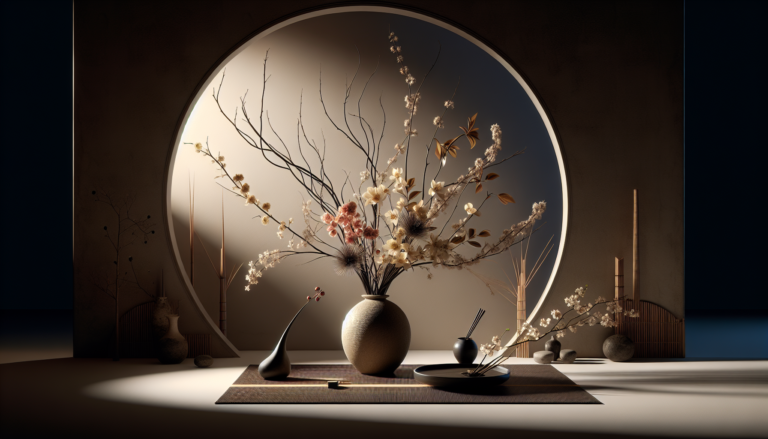As you wander through the serene gardens of Japan, you may stumble upon an arrangement of flowers that seems almost otherworldly. Delicate petals dance in harmony, suspended in mid-air like divine whispers. Ikebana is the ancient art of Japanese flower arrangement that transcends mere decoration. It’s an invitation to slow down, breathe in the beauty of impermanence, and find meaning in life’s fleeting moments. As you investigate the world of Ikebana, you’ll discover a philosophy that weaves together nature, art, and the human experience.
Origins of Ikebana
Your journey into the world of Ikebana begins with understanding its rich history and cultural significance. Delving into the origins of this traditional Japanese art form reveals a fascinating story of evolution and influence.
Historical Roots
In the 7th century, Ikebana was influenced by Buddhist rituals and ceremonies. During this time, flowers were used by the Buddha as a symbol of reverence and respect. As Buddhism spread throughout Japan, so did the art of flower arrangement, adapting to the country’s unique cultural landscape.
Influence of Japanese Culture
Japan’s deep connection with nature is one of the most significant factors shaping Ikebana. The country’s reverence for the seasons and its unique aesthetic sensibilities have instilled in Ikebana a profound appreciation for simplicity, harmony, and balance.
Historical records show that Ikebana was a form of artistic expression and a reflection of Japan’s social hierarchy. During the Edo period (1603-1867), Ikebana was a status symbol, with only the wealthy and noble classes able to afford the exotic flowers and materials required for these intricate arrangements. As you explore the world of Ikebana, you’ll discover how this art form has evolved, incorporating new styles and techniques while remaining true to its cultural heritage.
Principles of Ikebana
Any art form has its underlying principles, and Ikebana is no exception. As you explore deeper into Ikebana, you’ll discover that it’s not just about arranging flowers but creating a harmonious balance between nature and human creativity.
Harmony and Balance
On the surface, Ikebana may seem like a simple arrangement of flowers, but it requires a deep understanding of harmony and balance. You’ll need to consider each element’s shape, color, and texture to create a visually appealing composition that pleases the eye.
Emphasis on Nature
The principles of Ikebana emphasize the importance of connecting with nature. You’re not just arranging flowers; you’re working with living, breathing elements that evoke emotions and inspire contemplation.
Ikebana encourages you to slow down and appreciate the fleeting beauty of nature. As you work with the flowers, leaves, and branches, you’ll notice the intricate details, the subtle changes in color and texture, and how light interacts with each element. This mindfulness is at the heart of Ikebana, which sets it apart from other floral arrangements.
Styles and Techniques
While exploring the world of Ikebana, you’ll discover a rich tapestry of styles and techniques that have evolved over centuries. From traditional approaches rooted in Japanese culture to modern interpretations that push the boundaries of creativity, each style offers a unique perspective on this ancient art form.
Traditional Approaches
On the path of traditional Ikebana, you’ll find schools such as Ikenobo, Ohara, and Sogetsu, each with its distinct style and philosophy. These approaches emphasize harmony, balance, and simplicity, often featuring natural materials like cherry blossoms, chrysanthemums, and bamboo.
Modern Interpretations
Techniques like freestyle and avant-garde Ikebana have emerged, allowing artists to experiment with unconventional materials, colors, and forms. This modern wave of Ikebana encourages you to think outside the box, embracing imperfection and celebrating the beauty of impermanence.
To probe deeper into modern Ikebana, you’ll find that it’s not just about arranging flowers; it’s about storytelling, evoking emotions, and creating a sense of connection with nature. Modern ikebana artists often incorporate unexpected elements, like recycled materials, found objects, or even LED lights, to create thought-provoking and visually stunning pieces that challenge your perceptions of beauty and art.
To wrap up
With these considerations, you now hold the essence of Ikebana – a delicate dance of nature, art, and the human spirit. As you investigate this ancient Japanese art form deeper, you’ll find that it’s not just about arranging flowers but cultivating mindfulness, simplicity, and harmony within yourself. May your journey into the world of Ikebana be a path of discovery, where the gentle curves of a petal or the subtle scent of a bloom inspire you to slow down, breathe deeply, and appreciate the beauty in life’s fleeting moments.
